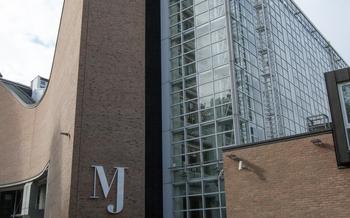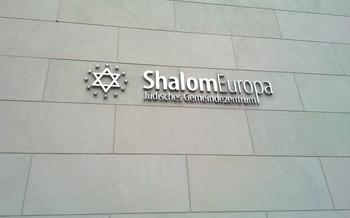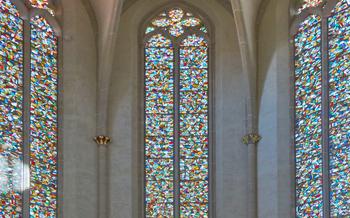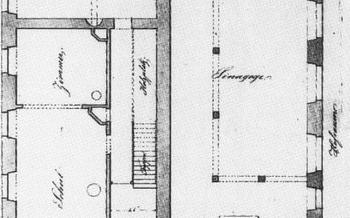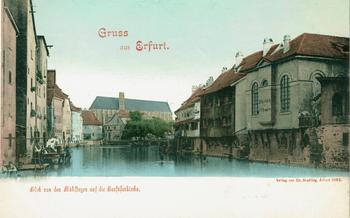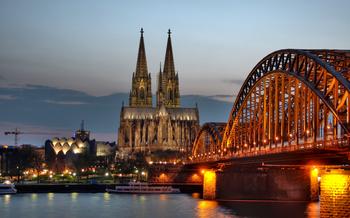
Old Synagogue
- Erfurt's Old Synagogue: A Historical Gem in the Heart of Germany
- The Synagogue's Transformation into a Memorial:
- Exhibitions and Artifacts:
- The Mikveh: A Ritual Bath
- The Old Jewish Cemetery: A Silent Witness to History
- The Erfurt Treasure: Unearthing a Legacy of Jewish Culture
- The Jewish Quarter
- The Jewish Museum: A Treasure Trove of Jewish History and Culture
- Synagogue Concerts and Events:
- The Erfurt Synagogue as a Symbol of Resilience
- The Role of the Synagogue in Modern Erfurt
- Practical Information for Visitors:
- Insider Tip: Erfurt's Hidden Jewish History
Erfurt's Old Synagogue: A Historical Gem in the Heart of Germany
In the heart of Erfurt, nestled amidst cobblestone streets and medieval architecture, stands the Old Synagogue, a testament to the city's rich Jewish history. Built in the 11th century, it is one of the oldest surviving synagogues in Europe and a poignant reminder of the vibrant Jewish community that once thrived in Erfurt.
The synagogue bears witness to the significant contributions made by the Jewish community to Erfurt's cultural and economic landscape. Jewish merchants played a crucial role in trade and commerce, establishing Erfurt as a flourishing trading center. Their expertise in various fields, including finance, medicine, and the arts, enriched the city's intellectual and cultural life.
Today, the Old Synagogue stands as a poignant symbol of resilience and continuity, having survived centuries of adversity, including the tumultuous period of the Holocaust. Its enduring presence serves as a reminder of the vibrant Jewish community that once called Erfurt home and the importance of preserving and honoring their legacy.
The Synagogue's Transformation into a Memorial:
After the devastation of World War II, the Old Synagogue in Erfurt stood as a symbol of resilience amidst the ruins. Extensive restoration efforts were undertaken to repair the damaged structure and preserve its historical significance. The synagogue's transformation into a memorial site and museum marked a pivotal moment in recognizing and honoring the Jewish history of Erfurt.
In 1952, the synagogue was declared a protected historical monument, and in 1967, it was officially opened as a memorial site. The restoration process involved meticulous attention to detail, ensuring the preservation of the synagogue's original features while incorporating modern elements to enhance its functionality as a museum.
The memorial site serves as a poignant reminder of the Holocaust and the persecution of the Jewish community during the Nazi regime. It features permanent exhibitions showcasing the history of Jewish life in Erfurt, from its vibrant beginnings to the tragic events of the 20th century. Through artifacts, documents, and personal stories, the museum provides a comprehensive narrative of the Jewish experience in the city.
Educational programs and guided tours are offered to visitors, allowing them to delve deeper into the history of the synagogue and the Jewish community. The memorial site serves as a place of remembrance, reflection, and learning, promoting understanding and reconciliation.
Exhibitions and Artifacts:
The Old Synagogue in Erfurt houses a series of permanent exhibitions that provide visitors with a deep understanding of Jewish life and culture in the city. These exhibitions showcase a diverse array of artifacts, documents, and personal stories that shed light on the rich history of the Jewish community in Erfurt and its contributions to the city's cultural and social fabric.
One of the highlights of the exhibitions is a collection of religious objects, including Torah scrolls, prayer books, and ritual items. These artifacts offer a glimpse into the spiritual traditions and practices of the Jewish community and provide insight into the daily lives of Jewish families in Erfurt.
Another important aspect of the exhibitions is the display of personal stories that bring the history of the Jewish community to life. Through letters, diaries, and photographs, visitors can learn about the experiences of individual Jews who lived in Erfurt, their joys and sorrows, their struggles and triumphs. These personal stories create a powerful connection between visitors and the past, allowing them to understand the human dimension of Jewish history in Erfurt.
In addition to the permanent exhibitions, the Old Synagogue also hosts temporary exhibitions that focus on specific themes or aspects of Jewish history and culture. These exhibitions often feature artifacts and documents from other museums and collections, providing visitors with a broader perspective on Jewish life in Germany and beyond.
Educational programs and guided tours are also offered at the Old Synagogue. These programs are designed to provide visitors with a deeper understanding of the history and significance of the synagogue and its exhibitions. Guided tours are led by knowledgeable guides who share their insights and expertise on Jewish history in Erfurt and answer visitors' questions.
The Mikveh: A Ritual Bath
The Old Synagogue in Erfurt is not only a historical gem but also part of a larger complex that includes a mikveh, or ritual bath. Located in the basement of the synagogue, the mikveh is a reminder of the vibrant Jewish community that once thrived in Erfurt.
History and Significance
Mikvahs have been an integral part of Jewish religious and cultural life for centuries. They are used for ritual purification before certain religious observances, such as the Sabbath and holidays. The mikveh in Erfurt is believed to date back to the 13th century, making it one of the oldest surviving mikvahs in Germany.
Restoration and Preservation
After falling into disrepair following the Holocaust, the mikveh was rediscovered and restored in the 1990s. Today, it stands as a testament to the resilience of the Jewish community and the importance of preserving their heritage.
Educational and Cultural Value
Visitors to the Old Synagogue can now explore the mikveh as part of their tour. It offers a unique glimpse into the everyday lives of the Jewish community and their religious practices. The mikveh also serves as an educational tool, helping to raise awareness of Jewish history and culture.
The Old Jewish Cemetery: A Silent Witness to History
Nestled amidst the serene landscapes of Erfurt lies the Old Jewish Cemetery, a poignant reminder of the city's rich Jewish heritage. Established in the 11th century, this sacred burial ground served as the final resting place for generations of Jewish inhabitants. Over the centuries, the cemetery expanded, becoming one of the largest and most significant Jewish cemeteries in Central Europe.
The Old Jewish Cemetery is a treasure trove of history, with its ancient gravestones silently narrating the lives of those who once called Erfurt home. Each tombstone bears witness to the joys, sorrows, and traditions of the Jewish community. Some stones are adorned with intricate carvings and Hebrew inscriptions, while others are more modest, yet each holds a unique story.
Notable burials include prominent rabbis, scholars, and community leaders who left an indelible mark on Erfurt's Jewish history. Visitors can pay their respects to Rabbis Moses Sofer and Abraham ben Samuel, whose wisdom and teachings shaped the spiritual and intellectual life of the community.
Beyond its historical significance, the Old Jewish Cemetery holds immense cultural and symbolic value. It represents the resilience and continuity of Jewish life in Erfurt, despite centuries of persecution and adversity. The cemetery serves as a poignant reminder of the vibrant community that once thrived in the city.
Today, the Old Jewish Cemetery stands as a protected historical site, meticulously maintained and preserved to honor the memory of those laid to rest within its grounds. Visitors are welcome to explore this sacred space, reflecting on the lives and legacies of the Jewish people who contributed to Erfurt's rich tapestry.
The Erfurt Treasure: Unearthing a Legacy of Jewish Culture
In 1998, Erfurt unearthed a remarkable treasure that shed new light on the city's rich Jewish heritage. During construction work near the Old Synagogue, a trove of silver coins, gold jewelry, and precious artifacts was discovered buried beneath the ground. This treasure, now known as the Erfurt Treasure, is believed to have been hidden by the Jewish community during the tumultuous period of the Black Death in the 14th century.
Significant Discovery:
The Erfurt Treasure is considered one of the most significant archaeological discoveries in Germany. It comprises over 3,000 coins, including rare and valuable pieces from the Middle Ages. The treasure also includes exquisite jewelry, such as necklaces, pendants, and rings, adorned with precious stones and intricate designs.
Historical Context:
The treasure's discovery provides a tangible link to the vibrant Jewish community that thrived in Erfurt during the Middle Ages. The coins and artifacts offer insights into their economic activities, trade networks, and cultural practices. The presence of valuable jewelry suggests the community's prosperity and the significance they placed on personal adornment.
Exhibitions and Display:
The Erfurt Treasure is now proudly displayed in the Old Synagogue's museum. Visitors can marvel at the intricate craftsmanship and historical significance of these artifacts. The exhibition provides detailed information about the treasure's discovery, its historical context, and its importance to understanding Jewish life in medieval Erfurt.
The Jewish Quarter
The Jewish quarter in Erfurt, known as the Krämpferstraßenviertel, is a historic neighborhood that once served as the heart of the city's Jewish community. Located in the Altstadt (Old Town), the quarter is centered around the Old Synagogue and encompasses several notable buildings and landmarks that showcase its rich cultural heritage.
Established in the Middle Ages, the Jewish quarter thrived as a vibrant center of learning, trade, and religious observance. The community constructed a synagogue, a mikveh (ritual bath), and a cemetery within the quarter, creating a self-contained enclave. The narrow, winding streets and half-timbered houses that characterize the area reflect the architectural style of the period.
One of the most prominent landmarks in the Jewish quarter is the Haus zum Stockfisch (House of the Dried Codfish), a 16th-century building that served as a Jewish school and community center. Other notable sites include the Judengasse (Jewish Lane), which was once lined with Jewish homes and businesses, and the Erfurt Treasure, a collection of medieval coins and artifacts discovered in the quarter in 199
Today, the Jewish quarter is a vibrant mix of history, culture, and contemporary life. While the Jewish community in Erfurt is no longer as large as it once was, the quarter remains a testament to the city's rich Jewish heritage. Visitors can explore the historic streets, visit the Old Synagogue and mikveh, and learn about the remarkable history of the Jewish community in Erfurt.
The Jewish Museum: A Treasure Trove of Jewish History and Culture
In the heart of Erfurt's historic Jewish quarter, nestled amidst centuries-old buildings, lies the Jewish Museum, a repository of the city's rich Jewish heritage. Established in 2007, the museum occupies a charming half-timbered house that once served as the Jewish community's schoolhouse.
Within its walls, the Jewish Museum invites visitors on a journey through time, showcasing the vibrant history and culture of Erfurt's Jewish community. Through a diverse collection of artifacts, documents, and multimedia displays, the museum tells the story of the community's triumphs and tribulations, their contributions to Erfurt's society, and their resilience in the face of adversity.
Exhibits delve into the daily lives of Erfurt's Jewish residents, shedding light on their religious practices, family traditions, and economic pursuits. Visitors can explore the intricate world of Jewish festivals and customs, learn about the community's involvement in trade and commerce, and gain insights into their unique contributions to Erfurt's cultural landscape.
Personal stories and testimonies bring the past to life, allowing visitors to connect with the individuals who shaped Erfurt's Jewish community. Through letters, diaries, and oral histories, visitors can hear the voices of those who lived through both joyful and challenging times, gaining a deeper understanding of their experiences and struggles.
The Jewish Museum serves as a vital center for education and dialogue, hosting regular events, workshops, and lectures that explore various aspects of Jewish history and culture. It collaborates closely with local schools and organizations to promote understanding and tolerance, fostering a spirit of inclusivity and respect within the Erfurt community.
Synagogue Concerts and Events:
The Old Synagogue in Erfurt resonates with the spirit of creativity and community beyond its historical significance. The space has been transformed into a vibrant venue hosting regular concerts, lectures, and cultural events that fuse Jewish heritage with contemporary expression. These events often collaborate with local musicians, artists, and scholars to create unique and immersive experiences for visitors.
The concerts held within the synagogue's hallowed halls offer a poignant blend of traditional Jewish melodies and contemporary compositions that resonate with the building's history and the universal human experience. The acoustics of the synagogue lend a distinct charm to the performances, creating an intimate and immersive atmosphere.
Lectures and talks delve into the rich history of the Jewish community in Erfurt, exploring their contributions to the city's cultural and intellectual landscape. Scholars, historians, and community members share their insights, offering visitors a deeper understanding of Jewish life and traditions.
These events serve as a bridge between the past and the present, fostering interfaith dialogue and understanding. They create a space for people from diverse backgrounds to come together, learn from each other, and celebrate the shared human experience. By attending these events, visitors not only witness exceptional performances but also contribute to the ongoing story of the Old Synagogue as a symbol of resilience and cultural exchange.
The Erfurt Synagogue as a Symbol of Resilience
Despite centuries of adversity, the Erfurt Synagogue has endured as a testament to the remarkable resilience of the Jewish community. Throughout its existence, the synagogue has faced numerous challenges, including political upheavals, anti-Semitic persecution, and the horrors of the Holocaust. Yet, through it all, the synagogue has remained standing as a symbol of Jewish continuity and strength.
The synagogue's survival is a poignant reminder of the indomitable spirit of the Jewish people. Despite the hardships they have faced, they have persevered and maintained their traditions and culture. The synagogue is a testament to their ability to overcome adversity and rebuild their lives time and time again.
Moreover, the synagogue's endurance serves as a powerful symbol of interfaith cooperation and understanding. In recent years, there has been a growing recognition of the importance of preserving and commemorating Jewish heritage. The Erfurt Synagogue has become a focal point for this effort, with people from all backgrounds coming together to learn about the history of the Jewish community and the significance of the synagogue.
The synagogue's resilience is an inspiration to all who believe in the power of the human spirit to overcome adversity. It is a symbol of hope and a reminder that even in the face of great challenges, it is possible to rebuild and create a better future.
The Role of the Synagogue in Modern Erfurt
The Old Synagogue in Erfurt stands not only as a testament to the city's rich Jewish history but also as an active and vibrant part of modern-day Erfurt. Its transformation into a memorial site and museum has made it a significant cultural and historical landmark, attracting visitors from around the world. The synagogue's presence contributes to Erfurt's diverse cultural fabric, promoting interfaith dialogue, understanding, and reconciliation.
Beyond its historical and cultural significance, the Old Synagogue plays a vital role in promoting tourism and cultural exchange in Erfurt. Its unique architectural features, coupled with the poignant stories it holds, make it a must-visit destination for both domestic and international tourists. The synagogue's integration into Erfurt's tourism infrastructure contributes to the city's economic growth and vibrancy.
Moreover, the synagogue serves as a platform for educational programs, workshops, and community events, fostering a deeper understanding of Jewish history, culture, and traditions among the local population and visitors alike. These initiatives promote interfaith dialogue, break down stereotypes, and build bridges of understanding between different communities.
The Old Synagogue's significance extends beyond its physical presence. It has become a symbol of resilience, representing the enduring spirit of the Jewish community in Erfurt and their ability to overcome adversity. Its survival through centuries of challenges serves as an inspiration for interfaith cooperation, understanding, and the promotion of a harmonious and inclusive society.
Practical Information for Visitors:
Plan your visit to the Old Synagogue and the Jewish Quarter of Erfurt with ease using this practical guide:
Opening Hours and Admission:
- The Old Synagogue is open to visitors Tuesday through Sunday from 10 am to 5 pm.
- Admission fees are as follows: adults 4 euros, reduced rate (students, seniors) 2 euros, and children under 14 are free.
- Guided tours are available for groups of 10 or more and must be booked in advance.
Accessibility:
- The Old Synagogue is wheelchair accessible, with ramps and elevators throughout the building.
- Guided tours can be adapted to accommodate visitors with disabilities.
- Audio guides in various languages are available for rent at the information desk.
Tips for Planning Your Visit:
- Allow at least one hour to explore the synagogue and its exhibitions.
- Guided tours are highly recommended, as they provide in-depth insights into the history and significance of the site.
- Combine your visit with a walk through the nearby Jewish Quarter, where you can discover other remnants of Erfurt's Jewish heritage.
- Visit the synagogue during one of the regular concerts or events to experience the space's vibrant cultural atmosphere.
Insider Tip: Erfurt's Hidden Jewish History
Beyond the Old Synagogue and the Jewish Museum, Erfurt holds many hidden gems that reveal its rich Jewish past. Take a stroll through the historic Jewish quarter, where you'll find remnants of the city's once-thriving Jewish community. Look for the Stolpersteine (stumbling stones), small brass cobblestones inscribed with the names of Jewish victims of the Holocaust, placed in front of their former homes.
Visit the site of the former Great Synagogue, destroyed during Kristallnacht in 193Today, a memorial plaque marks the spot where the grand synagogue once stood. Explore the Erfurt City Museum, which houses a collection of artifacts and documents related to the city's Jewish history, including medieval manuscripts and ritual objects.
For a self-guided walking tour, follow the Erfurt Jewish Heritage Trail, which leads you to significant Jewish sites around the city, including the former Jewish school, the mikveh, and the Jewish cemetery. Erfurt's Jewish history is a testament to the resilience and contributions of the Jewish community, and these hidden gems offer a glimpse into their vibrant past.

